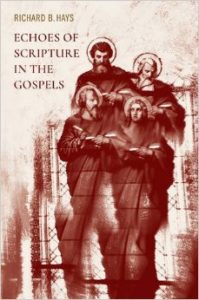
Echoes of Scripture in the Gospels
Richard B. Hays. Echoes of Scripture in the Gospels. Waco: Baylor University Press, 2016, 524 pp. $47.48.
Reviewed by Daniel Hasbun
In this long-awaited sequel to his 1993 book Echoes of Scripture in the Letters of Paul, Richard Hays again takes up the task of intercanonical criticism with remarkable erudition and clarity. The book’s introduction concisely describes its central aim: to examine “the ways in which the four Evangelists reread Israel’s Scripture—as well as the ways in which Israel’s Scripture prefigures and illuminates the central character in the Gospel stories” (7). Hays does a fine job of establishing the link between this thesis and each of his subsequent points without being unnecessarily hampered by theoretical or cumbersome asides.
The structure of the book—which is helpfully delineated in the introduction (8–9)— mirrors its thesis: each chapter is dedicated to the intercanonical analysis of one of the four Gospel accounts. Though subsections within each chapter are meant to draw special attention to how Scripture informs the evangelists’ Christologies and ecclesiologies, Hays’s method of analysis remains largely uniform throughout the book. By closely reading certain key passages in the Gospels, Hays makes explicit their “echoes” of Israelite Scripture and highlights the ways that their use enriches the meaning of the Gospel passage. Here, Hays defines an “echo” as a type of reference that is slightly more discreet than a direct quotation. If someone were to mention the quality of mercy, for instance, readers steeped in Shakespeare would understand this “echo” without any explicit mention of the Bard. Hays concedes that the Gospels are largely intelligible without reference to these “echoes,” but nonetheless suggests that their recognition will unlock deeper levels of meaning in the texts and in their portrayals of Jesus. In fact, these references may precisely be the means by which those who have ears to hear will hear.
It is apparent that Hays is taking up a gargantuan interpretive task in this book, and his ability to unclutter the convoluted language of New Testament scholarship while maintaining scholarly precision should be lauded. As mentioned above, the book’s introduction explicitly outlines what the reader should expect to find in the remainder of the book: it includes a lengthy explanation of what he calls “figural interpretation” (2– 6), Hays’s thesis (7), an outline of each chapter (8–9), and finally a brief—albeit thoroughly informative—description of Hays’s interpretive methodology (10). This section feels less like a merely formal introduction and more like some privileged access to Hays’s private notes and outlines. Hays’s penchant for lucidity does not end in the introduction, however: Hays incessantly references his thesis after almost every passage he analyzes, as well as in miniature introductions and conclusions in each of his four Gospel chapters. These reminders, which are made so frequently that they almost become counterproductive and distracting, make up in clarity what they lack in subtlety.
Hays calls his reference-conscious form of analysis an exercise in “figural reading,” or “the discernment of unexpected patterns of correspondence between earlier and later events or persons within a continuous temporal stream” (347). In other words, Gospel references to past events may uncover hidden meaning in contemporary ones; conversely, contemporary events may highlight an otherwise overlooked detail in past events. To demonstrate this sort of reading within the Gospels, Hays draws attention to John 12:16: “His disciples did not understand these things at first; but when Jesus was glorified, then they remembered that these things had been written of him” (312). Hays repeatedly points out that just as the disciples scrutinized the Scriptures in light of the present resurrection (and vice versa), so should modern readers be just as mindful of the numerous “echoes” buried in the Old Testament and Gospels alike.
Though Hays rarely departs from the meticulous plan laid out in the book’s introduction, he occasionally turns from his sensu stricto textual analysis to pursue other topics. Sometimes this works out well, and other times this proves to be more distracting. One successful example is Hays’s criticism of the low/high Christology duality perpetuated by modern New Testament scholarship. Through his analysis of each Gospel, Hays demonstrates that each text’s complexity and distinct narrative style leaves little room for each Gospel to be described as exclusively containing a low or high Christology. Hays dedicates a few paragraphs to this criticism in each of the Gospel chapters and in the book’s conclusion, leaving him ample room to make a convincing argument against the use of such restrictive categories. Hays breaks from his plan less successfully whenever he attempts to make a polemic against violence. While describing the Jews’ response to Pilate (“his blood be on us and on our children”) in Matthew 27:25, Hays interjects by saying that “violence rests on an incomplete and therefore faulty reading of Matthew” (133). Whether this is true or not, this claim is unfounded in the rest of the work.
Despite these brief asides, the book is extremely well-organized and an absolute delight to read. Its tight form displays a self-awareness and humility that is unparalleled in much of New Testament scholarship: Hays puts away scholarly esotericisms in favor of repetition and careful wording. In this way, he does a superb job of expositing the Gospels and providing yet another way for any reader to fall in love with the immense complexity and poetry of the Bible.
Daniel Hasbun, MA(TS) Student, Princeton Theological Seminary
